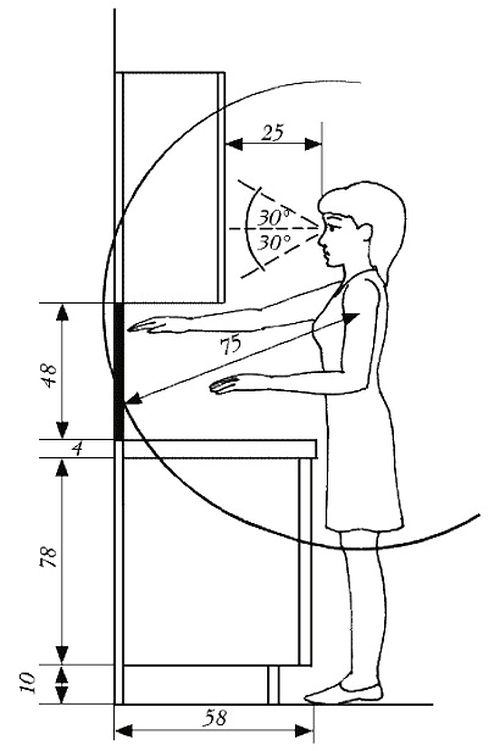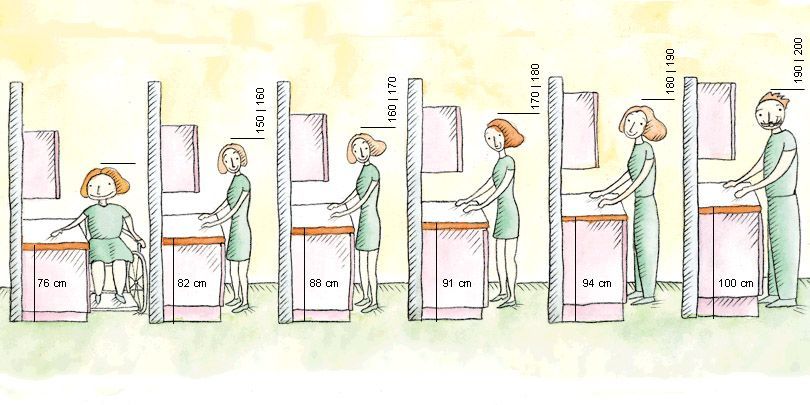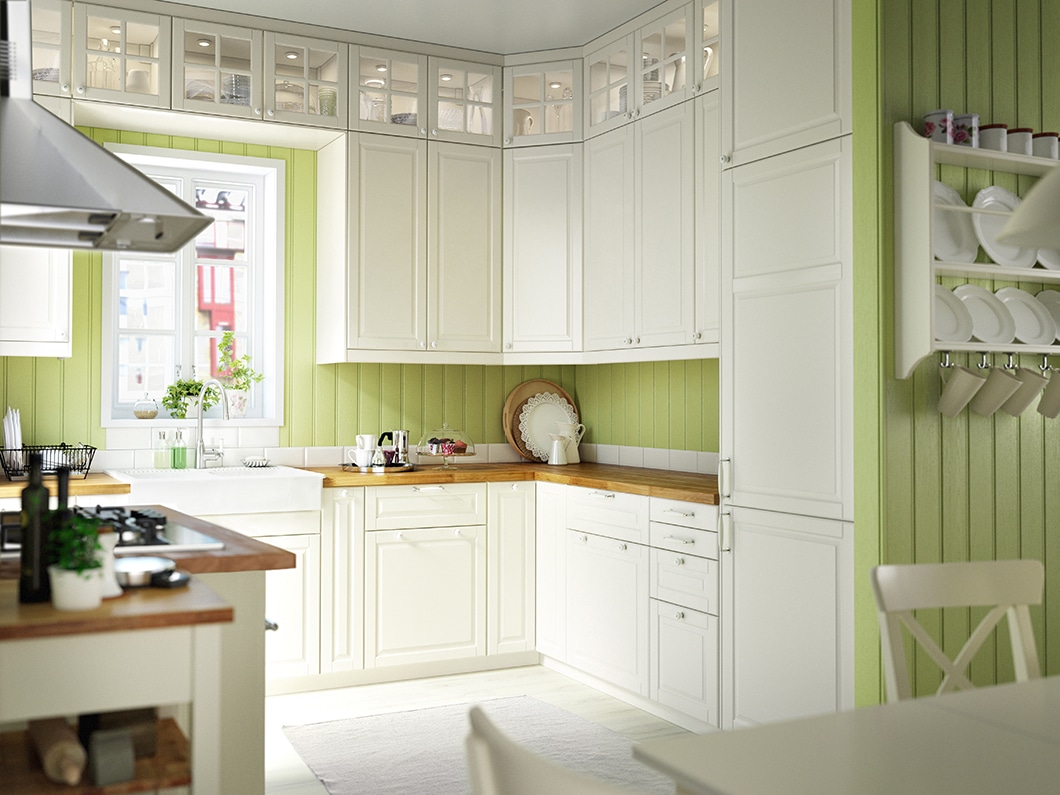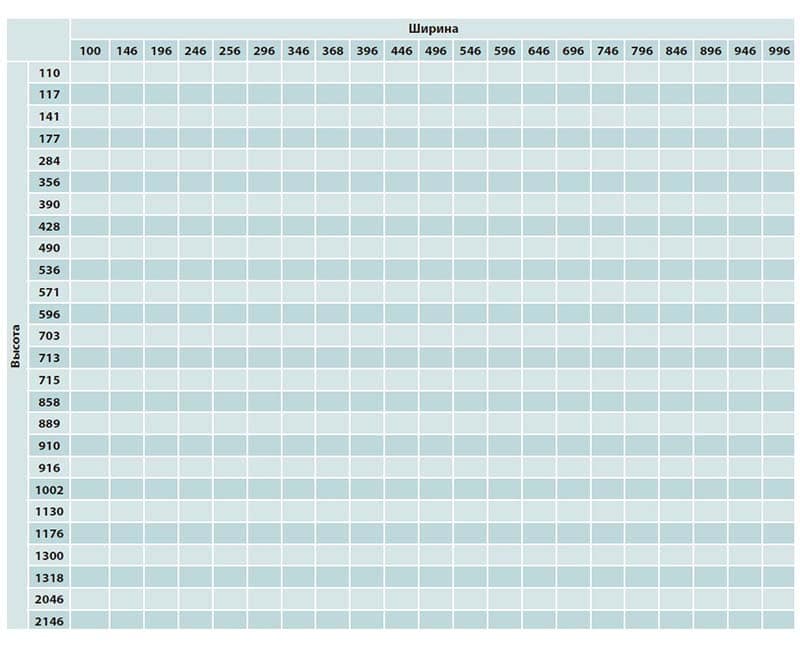How to determine the standard size of kitchen cabinets and overall dimensions of the kitchen unit
Those of the readers who took up the interesting but difficult task of designing their own kitchen independently, among other questions ask: what are the optimal height of the kitchen set from the floor and the size of the kitchen cabinets. Undoubtedly, the layout of the kitchen set is largely determined not only by considerations of ergonomics, design, but also by the presence of dimensional standards. After all, making fully individual furniture is rather laborious and not always cheap. In most cases, standard elements (modules) are used, of which, as from cubes of Lego, a kitchen set is added to the size of the kitchen.
Optimal dimensions of the kitchen set
In stores of finished furniture, the sizes of kitchen sets displayed in the hall and being sold “as is” often correspond to the dimensions of a typical domestic dwelling. However, there are no unambiguous rules and rules that clearly dictate what the size of the kitchen set should be. The standard (conditional) is information to note, and not guidance in the case when we design furniture for a specific room and the individual needs of its owners. In typical apartments, the overall dimensions of the kitchen set and its configuration dictate the dimensions of the room. So, in the “Khrushchev” size of the headset in the case of the L-shaped layout of the kitchen is about 2.6 x 1.1 m, in the “Brezhnevka” is closer to 2,8 x 1,8 m.

Headset for a typical apartment
The height of the kitchen cabinets from the floor to the top of the furniture also depends on the height of the ceilings in the room. In the already mentioned “Khrushchev”, where you can freely reach the ceiling with your hand, you will not be particularly “overclocked”. The standard height of the 215 cm headset will just be right. In the “brezhnevke” and typical apartments of modern construction, this parameter can be more – 240 cm, if you use the upper row of increased height. And in the “stalinka”, where the ceilings are not below three meters, you can safely put the upper cabinets in two or even three rows. All such rarely used utensils will fit into this mezzanine.

Furniture from the Ikea room show. The height of the kitchen cabinets (modules) is typical, but on their basis an effective headset for a room with a high ceiling
Thus, the standard size of a kitchen set is not quite the right concept for furniture made to order. And it is by individual “measures” that today almost all kitchen sets are made. Lockers at the same time are sufficiently standardized in size. Let’s talk about them in more detail.
Standard Module Sizes
Modern kitchen – a modular product, it is assembled from separate modules of the lower and upper rows, high cabinets. At the level of state regulation, no norms or rules determine the size of kitchen cabinets. The standard, however, exists, albeit unofficial. The dimensions used are dictated by practical experience, the recommendations of scientists dealing with ergonomics, take into account the features of the technology of manufacturing and assembling furniture. Designers of furniture and its manufacturers by default observe similar standard sizes. The dimensions of the modules, however, may differ slightly depending on the model. Let’s consider what standards of furniture are available for the kitchen.

A variant of a dimensional grid of furniture modules
Width of cabinets of upper and lower tier
The width standards are observed by all manufacturers. Firstly, it is convenient when designing and installing furniture: it is much easier to operate with simple round figures in decimeters than calculating fractions and millimeters. Secondly, all built-in home appliances are designed for a typical size, the standards for all equipment manufacturers are the same.

Dimensions of the recess for the built-in oven of 60 cm width
European furniture manufacturers have the following standard sizes in width:
Narrow – 15, 20 and 30 cm. As a rule, they are used in the lower row of furniture. Narrow modules are equipped with pull-out bottles (cargo) or used for open storage of wine, but in this case the case is only open at half depth, the far part is muffled. The 30-cm module is sometimes equipped with shelves and a swinging door, but the opening for storage is 26 cm and it’s not very convenient.
Modules of medium width: 40, 45, 50 and 60 cm, perhaps, are the basis of budget furniture. 45 and 60 cm – the standard for embedded technology. In the lower row are equipped with shelves and drawers, in the upper – mostly shelves.

Habitual inexpensive furniture with narrow (up to 60 cm) modules and facades
Wide – 80 and 100 cm. At the lower level can be equipped with shelves or wide drawers, used for sesquistas or double sinks. Top – drying for dishes, shelves with opening to the side or lifting doors.

For wide drying, opening up the façade is most convenient
Modules of increased width: 120 cm and more. With the access to the market of comfortable, reliable, capable of carrying a large load of retractable and lifting opening mechanisms, it became possible to make boxes of the lower and upper rows very wide. In modern top-level furniture, pull-out and lifting elements up to 180 cm wide can be seen. Gas elevators and electric-drive opening systems are increasingly used for upper cabinets. To name modules of the increased width standard while it is impossible, but, probably, soon they become that.

A drawer of meter width is not uncommon today
Width of high modules: 20 and 30 cm (equipped with retractable cargo), 45, 50 and 60 cm. Columns with a width of 45 and 60 cm are intended for built-in appliances.

Another variant of the dimensional range of modules, the dimensions are given by the facades, you need to add 4 mm per element
Depth of floor and mounted modules
The depth of the kitchen set, as a rule, is standard. It is determined by the dimensions of the built-in equipment and the depth of typical countertops, which is 60 or 62 cm. The standard depth of the lower kitchen cabinets is 57 cm along the side wall. Together with the door it is approximately 59.5 cm – 1.5 cm remains on the overhang table top in front. The depth of the body in its external dimensions of 57 cm does not mean that the inner depth is the same. As a rule, the rear wall is installed in the groove at some distance from the edge, this allows, if necessary, to be laid behind the communication. The depth of the inner space is about 55 cm. For most of the ovens, refrigerators, dishwashers and other modular equipment, a depth of 55 cm is also required.
If necessary, you can make a non-standard kitchen set. Dimensions of its depth can be less or more than typical. If less – in the boxes of the bottom row there should be no built-in equipment. A narrow sink for them, a candy bar and even a refrigerator can be purchased. With deeper lower elements in general, there are no problems, only they will cost more, including at the expense of a tabletop of increased depth.
Dimensions of hanging kitchen cabinets are not limited by the dimensions of the built-in equipment, it is not installed there. Except for cases for built-in hoods, which, however, are not often used. The depth of the upper cabinets of the kitchen is determined from the considerations of ergonomics and is approximately half the depth of the lower ones. If you make them deeper, the person will already rest against the door with his forehead. There is no single mandatory standard, but the depth of the kitchen cabinets for most manufacturers in the case without a door (on the side wall) is 30 or 33 cm.

It is possible to make a working surface deeper than 60 cm, but there is no sense
Height of kitchen cabinets
The only dimension where furniture manufacturers do not adhere to the general rules is the height of the kitchen cabinets. The standard, conditioned by the requirements of ergonomics, is available, but the producers consider it as a general recommendation, and not an obligatory condition. The height of different models may differ, although not much.
The recommended height of the lower cabinets of the kitchen is 72 cm, while the height of the working area depends on the choice of legs (supports) and their adjustment.

The height of the working surface depends on the growth of a person and is regulated by the supports
Often the height of the upper cabinets of the kitchen is the same. The standard of 72 cm allows you to use for the upper and lower rows of standard doors, furniture with equally high facades looks harmonious. In addition to the named type, there is a reduced (36 and 60 cm) and an enlarged (90 and 92 cm) height of the upper kitchen cabinets.

Conventional and corner cabinets Ikea for the kitchen, Series Method / Budbin, height of the upper row 100 cm
It must be said that the size of the kitchen cabinets is determined by the facade. Just on the height of the doors of their manufacturers there are different interpretations: each factory has its own, slightly different from the others, dimensions.

One of the variants of the size range of factory facades from MDF. Dimensions of the module will be 1.5-2 mm larger in each of the sides, allowance is made for the gaps between adjacent doors
For example, for conditionally 72-centimeter cabinets, the doors of different factories are similar, but still slightly different. Accordingly, you can meet the headset, the size of the lower modules are 71.2; 71.4; 71.5; 71.6; 71.8; 72.3 cm and this is not the whole list.

In addition to the lower, upper and tall modules, there are also elements that are installed on the countertop, in the photo on the right. Basically it is glass sideboards
For high cabinet-bars, there are also standard sizes. The kitchen set has a common height, which consists of the heights of the cabinets of the lower and upper rows, the gap between them and the thickness of the countertop. The recommended distance between the upper and lower cabinets of the kitchen is 50-60 cm. Among the typical heights of high cabinets is 200; 204; 210 and 230 cm, there are other options.
In conclusion, we recall that individual designing of furniture is a creative process and there is always a place for non-standard solutions in it. If you feel that your own imagination and knowledge of the subject is not enough – contact the furniture designer, a professional will tell you the best solutions and help you avoid mistakes.


